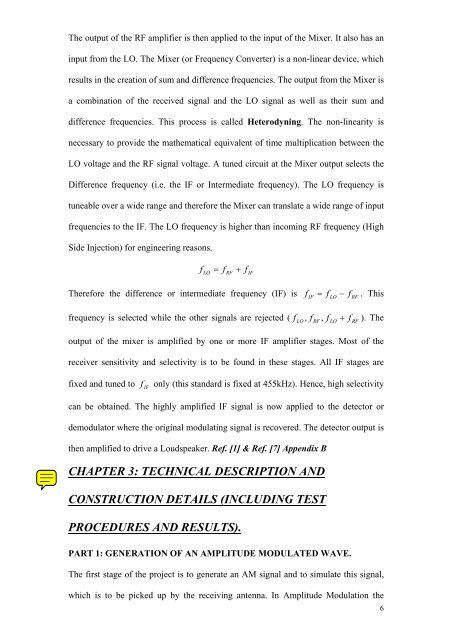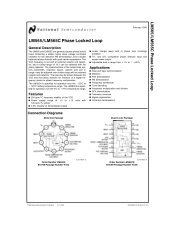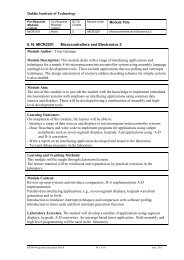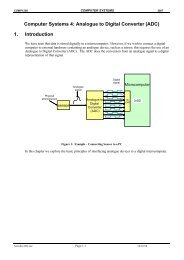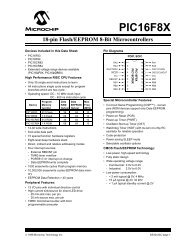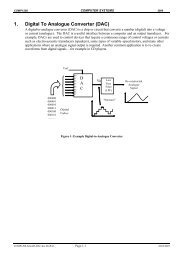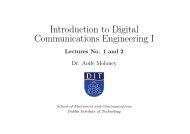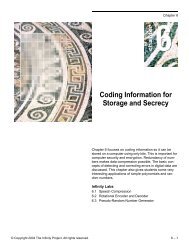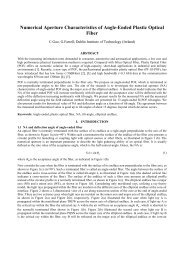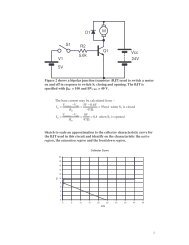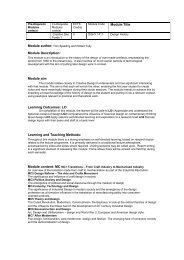simulation of a superheterodyne receiver using pspice - School of ...
simulation of a superheterodyne receiver using pspice - School of ...
simulation of a superheterodyne receiver using pspice - School of ...
Create successful ePaper yourself
Turn your PDF publications into a flip-book with our unique Google optimized e-Paper software.
The output <strong>of</strong> the RF amplifier is then applied to the input <strong>of</strong> the Mixer. It also has an<br />
input from the LO. The Mixer (or Frequency Converter) is a non-linear device, which<br />
results in the creation <strong>of</strong> sum and difference frequencies. The output from the Mixer is<br />
a combination <strong>of</strong> the received signal and the LO signal as well as their sum and<br />
difference frequencies. This process is called Heterodyning. The non-linearity is<br />
necessary to provide the mathematical equivalent <strong>of</strong> time multiplication between the<br />
LO voltage and the RF signal voltage. A tuned circuit at the Mixer output selects the<br />
Difference frequency (i.e. the IF or Intermediate frequency). The LO frequency is<br />
tuneable over a wide range and therefore the Mixer can translate a wide range <strong>of</strong> input<br />
frequencies to the IF. The LO frequency is higher than incoming RF frequency (High<br />
Side Injection) for engineering reasons.<br />
f = f +<br />
LO<br />
RF<br />
f<br />
IF<br />
Therefore the difference or intermediate frequency (IF) is<br />
f<br />
IF<br />
= f − f . This<br />
LO<br />
RF<br />
frequency is selected while the other signals are rejected ( f<br />
, f , f + f ). The<br />
output <strong>of</strong> the mixer is amplified by one or more IF amplifier stages. Most <strong>of</strong> the<br />
<strong>receiver</strong> sensitivity and selectivity is to be found in these stages. All IF stages are<br />
LO<br />
RF<br />
LO<br />
RF<br />
fixed and tuned to<br />
f IF<br />
only (this standard is fixed at 455kHz). Hence, high selectivity<br />
can be obtained. The highly amplified IF signal is now applied to the detector or<br />
demodulator where the original modulating signal is recovered. The detector output is<br />
then amplified to drive a Loudspeaker. Ref. [1] & Ref. [7] Appendix B<br />
CHAPTER 3: TECHNICAL DESCRIPTION AND<br />
CONSTRUCTION DETAILS (INCLUDING TEST<br />
PROCEDURES AND RESULTS).<br />
PART 1: GENERATION OF AN AMPLITUDE MODULATED WAVE.<br />
The first stage <strong>of</strong> the project is to generate an AM signal and to simulate this signal,<br />
which is to be picked up by the receiving antenna. In Amplitude Modulation the<br />
6


